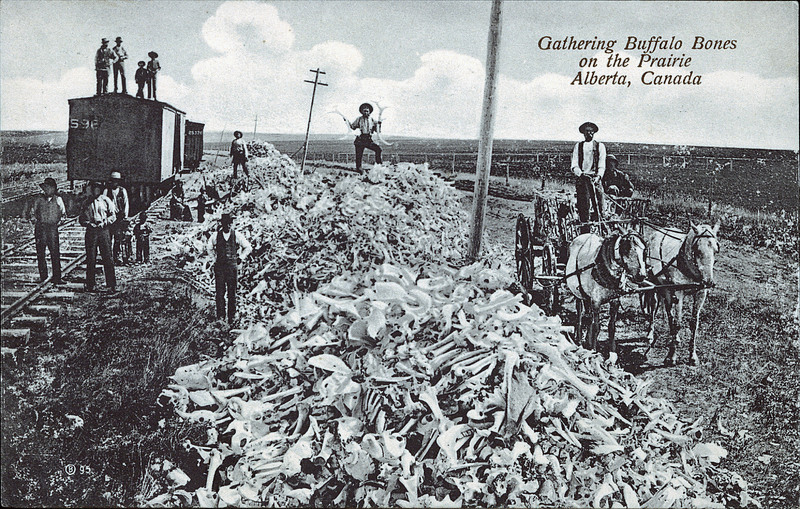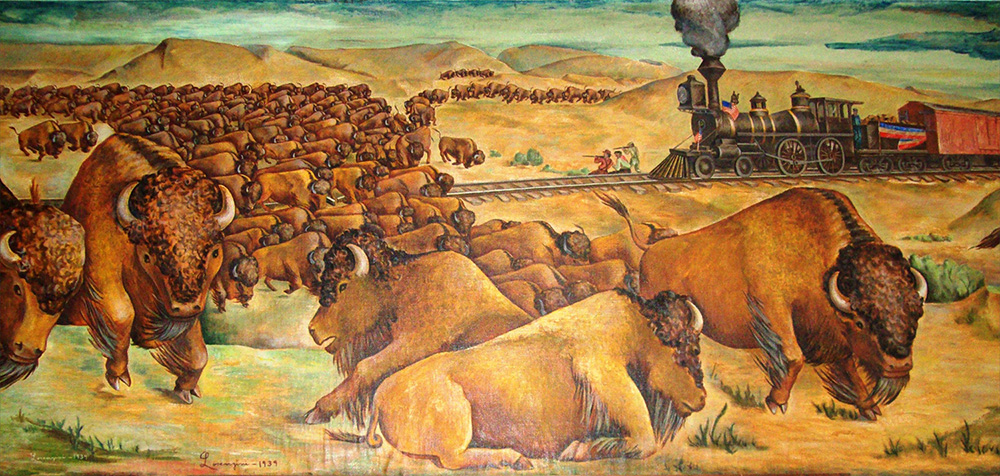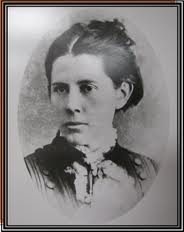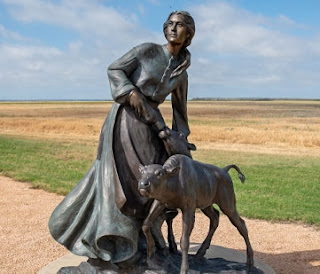Last week we learned about the rise of women in the world of agricultural education and the FFA. This week we will learn about a lady who was substantially responsible for saving the bison from extinction. If you teach Animal Science or Natural Resources, you might want to pay special attention to this Footnote. I learned about Molly Goodnight a few weeks ago while I was in the panhandle area of Texas and wanted to share what I learned with you.
Setting the Stage
In the 1800s it was estimated that 60 million bison roamed the Great Plains. Early pioneers and explorers reported seeing bison as far as the eye could see. One herd of bison observed by a Col. Richard Dodge was fifty miles wide and took five days to pass a specific point on their way north.
ln 1870 an army officer said “the plains were alive with bison, and in crossing at places I had difficulty in avoiding them, so vast were the herds. If anyone had told me then that in twenty or thirty years they would have become almost entirely extinct, I should have regarded the statement as that of an insane person.”

Figure 1. The Herd. DeGolyer Library, Southern Methodist University.
The Europeans who first arrived on the prairie had no word for this animal. They used an existing word “buffalo” from the French “boeuf” (beef). About 100 years ago scientists wanted to distinguish between the American animal and African and Asian buffalo, so the Latin term “bison” was settled on. Both buffalo and bison are used interchangeably in America.
The Near Extinction of the Bison
There were numerous reasons why the bison was on the verge of extinction in the late 1800s.
Industrial Hunters – There was a demand for bison hides, hooves and bones and tongue. Each bison had a value estimated at $5; the robe $2.50; the tongue 25 cents; hindquarter $2; bones, horn and hoofs, 25 cents. A man who could not make a living at anything else went out to kill buffaloes. The buffalo were killed by the tens of thousands.
The bones and skulls left behind by the industrial hunter were collected and shipped to St. Louis or Detroit where they were ground up for fertilizer and used in other industrial processes.

Figure 2. Postcard showing gathering of buffalo bones to ship to the east. Source: University of Alberta Libraries.

Figure 3. Men standing with pile of buffalo skulls, Michigan Carbon Works, Rougeville MI, 1870s. (Burton Historical Collection, Detroit Public Library)
An article in the Brenham (TX) Weekly Banner (1878, January 4) stated:
We learn from the San Saba News some interesting particulars regarding the wholesale slaughter of the bison (buffalo) on the plains. It is estimated that at least two thousand persons are now encamped on Texas soil for the sole purpose of slaughtering the bison. These men have reduced the hunt to a system and are as thoroughly organized as a well drilled army. The plan is to surround the whole buffalo range, which is done by sending out parties hundreds of miles from the settlements and completely encircle their prey, thus cutting off the retreat. Regular hunters supply stores have been established at convenient localities. The hunt is kept up during the entire year. The hides are sent to market – some of the meat is cured and sold, though the principal part is thrown away. The number killed annually amounts to hundreds of thousands. There should be some legislation to prevent this wholesale slaughter and waste.
The U.S. Government (i.e. the Army) – In the 1860s the US Army attempted to subdue the Plains Indians in order to make way for white settlers and railroad lines. Federal officials recognized the importance of bison on the Plains, where Native nations had yet to be forced onto reservations. In 1873. the Secretary of the Interior noted that “[t]he civilization of the Indian is impossible while buffalo remain on the plains”; following this logic, the Army provided free ammunition to hide hunters, who brought bison to the brink of extinction. In 1873 the American government killed 1.5 million buffalo in that one year alone to starve the native Americans so they would become dependent on the American Government to survive (Scheffer,, 1983)
One army colonel (Richard Dodge) told a hunter who had killed 30 bison and felt guilty about it the following – “Kill every buffalo you can! Every buffalo dead is an Indian gone.” General Phil Sheridan appeared before the Texas legislature in 1875 and suggested that every buffalo hunter be given a medal with a dead buffalo on one side and a discouraged Indian on the other side. He added that once the buffalo was exterminated, the Indians would be controlled, and civilization could advance.
The Railroads – The bison interfered with building the railroads across America. The bison would actually charge the trains. The railroads hired hunters to eliminate the buffalo and to also provide food for the railroad workers.
An article from the Prince George’s (MD) Enquirer (February 9, 1900) tells about the experience of army officer in 1871-1872:
“I was at that time on duty in the pay department, which made it necessary for me to travel on the Atchison, Topeka and Santa Fe railroad. One day the train entered a large herd, which scattered and seemed to go wild at the shrieking of the whistle and the ringing of the bell. As we went on the thicker they became, until the very earth appeared to be a rolling mass of humps so far as we could see. Suddenly some of the animals nearest us turned and charged; others fell in behind, and down on us they came like an avalanche. The engineer stopped the engine, let off steam and whistled to stop them, while we fired from the platforms and windows with rifles and revolvers, but it was like trying to stay a tidal wave. On they came, the earth trembling, and plunged heads down into us. Some were wedged in between the cars, others beneath; and so great was the crush that they toppled three cars over and actually scrambled over them, one buffalo becoming bogged by having his legs caught in the window. Such accidents occurred several times, and twice in one week were trains derailed by charging buffaloes, whose numbers it was impossible to compute.

Figure 4. A painting from the Hebron, Nebraska post office. Eldora Lorenzini was the artist. The buffalo herds were so large they could stop trains for hours. Passengers would often get out and shoot the buffalo.
Sportsmen? – On May 10, 1868 General William T. Sherman wrote a letter to General Philip Sheridan and said “I think it would be wise to invite all the sportsmen of England and America there [referring to the Great Plains] this fall for a Grand Buffalo hunt, and make one grand sweep of them all [all being both buffalos and Indians]. During this era many “sportsmen” availed themselves of the opportunity to hunt buffalo and the army often sent soldiers along as escorts. (Smits, n.d.)
Colonel Dodge, who was an avid hunter, took three English gentlemen on a twenty-day hunt in Kansas in the fall of 1872. They killed 127 buffalo. A year later the same party killed a comparable number of buffalo.
Grand Duke Alexis, third son of the Czar of Russia was accompanied by two companies of infantry, two of calvary and a regimental band for a five day hunt in North Platt, Nebraska in in 1872, It was reported the “exuberant hunting party slaughtered hundreds of buffalo.”
The Decatur (IL) Daily Republican for December 8, 1874 reported:
In the coming spring one hundred English “swells” are coming over to enter upon the grand hunting season on the western plains. The hunt is to be organized on a magnificent scale. One hundred Texas rangers will accompany them, and in addition to a vast retinue of servants, cooks, grooms. valets, etc. they will be accompanied by the brass band, which will discourse sweet music as they gather around their cheerful campfire to partake of the evening meal. They will hunt the grizzly to his mountain vastness, and slaughter the lively bison by thousands on the plains. It is estimated that these modern Nimrods , with their Texan reinforcement – two hundred guns in all – will be able to slaughter an average of 500 buffaloes per day. In two months, throwing off a liberal per centage for bad weather and unfavorable conditions, they ought to bag, say 30,000.
The three paragraphs above are samplings of the “sportsmen” who came to America to hunt the buffalo. There were thousands more.
Native Americans – The native Americans depended upon the bison for food, robes and tools made of bone for their existence but the number of bison they killed contributed little to the near extinction of the bison.

Figure 5. The Last of the Herd. Painting by Henry Farney in 1906. Cincinnati Art Museum. Farney R. and Grace K. Wurlitzer Foundation
Between 1872 and 1875 an average of 5,000 bison a day were killed every day of the year as 10,000 hunters poured onto the plains. Hides were collected along with the tongue. Most of the bison was left to rot. A railway engineer said it was possible to walk 100 miles along the Santa Fe railroad right of way by stepping from one bison carcass to another.
By mid-year 1883 nearly all of the bison in the United States were gone. An article in the Las Vegas (NM) Gazette (March 2, 1886) reported “Two loads of antelopes, both hides and meat, were brought in Friday night by D. Carter from the staked plains of Texas. There was one buffalo robe among the skins, and this solitary representative was all that they saw of the great herds of bison which once roamed over these western plains.”
In 1887 the American Museum of Natural History in New York wanted to obtain some bison specimens (by taxidermy) for an exhibit. They mounted an expedition to Montana and could not find a single bison.
In 1889 there were less than 100 wild bison in the United States. The All About Bison web site reports that the number of bison running wild and unprotected in the United States as of January 1, 1889 to be 85. Where were they?
· Panhandle of Texas – 25
· Colorado – 20
· Southern Wyoming – 26
· Musselshell County – Montana – 10
· Western Dakota – 4
Enter Molly Goodnight
While most of the literature about saving the bison mention Charles Goodnight (also known as Charlie) the real driving force in saving the bison was Molly Goodnight, the wife of Charles [Curator’s Note: Charles Goodnight co-established the Goodnight-Loving Cattle Drive Trail and was the inspiration for Larry McMurtry’s epic book, Lonesome Dove).

Figure 6. Mary Ann (Molly) Goodnight
This article in the Topeka Daily Capital (December 6, 1898) is typical of those that recognize Charles Goodnight as one of the saviors of the bison:
The timely formation of Goodnight’s herd and the formation of four other private herds, along with government protection of a wild herd at Yellowstone National Park, saved the species from extinction. Those few herds provided the founding stock that produced nearly all plains bison in existence today.
Goodnight donated to several early bison conservation efforts, such as those at Yellowstone, the National Bison Range and Canada’s national parks. He sold animals to numerous other parks, private individuals and zoos, including “Buffalo Bill” Cody and the New York Zoological Park, which was instrumental in establishing the first U.S. bison preserves.
However, saving the bison was his wife’s idea. In a letter to the Chicago Tribune (May 23, 1980) A. H. Reynolds writes “Mr. Goodnight used to kill thousands of buffalo when on the road, but owing to a happy suggestion of Mrs. Goodnight in time lassoed a lot of the young buffalo calves and preserved the race before too late.”
The Texas State Historical Association website has a very informative article about Molly (Roach, 1995). To learn more about her as a person, I highly recommend it. In regard to the bison this is what the article says:
While Molly’s life centered on the traditional chores of ranch life, however, her interests extended to protecting baby buffalo left to die after commercial hunters ravaged the Plains. Through rescuing and raising orphaned buffaloes Mrs. Goodnight helped establish the Goodnight buffalo herd, which became well known throughout the world. Some buffalo were also crossbred with range cattle to produce “Cattalo.” Molly also had a separate herd, first in Colorado under her PATM brand and later in Texas under the Flying T brand.
In an article titled “THE PASSING OF THE BIG BUFFALOES A Women Started the Now Famous Goodnight Herd” that appeared in the Harrisburg (PA) Telegraph dated December 15, 1898 we learn:
When Mrs. Goodnight realized the inevitable wiping out of the buffalo, she urged her husband to endeavor to preserve them. He set aside at her request 600 acres from his great ranch of 60,000 acres for buffalo park. In a letter telling of his start as a buffalo raiser, Mr. Goodnight said:
“In the spring of 1879- to be exact, May 15th- at my wife’s request, started out to look for some young buffalo. At last I found a few younger ones in Palo Duro canyon, and ‘roped’ them from horseback. The month following W.W. Dyer, my wife’s brother, caught two young females. From this start we have now a herd of forty-five purebred buffaloes. In 1884 I began to cross them with Polled Angus and Galloway cattle, and have a herd of sixty of these cross-breeds. This year we have been fortunate in getting fifteen buffalo calves.”
The final sentence in this article states “Her interest in her buffalo herd is unflagging, and, if the race of the typical American beast survives, it will be mainly owing to her efforts.”

Figure 7. A statue of Molly Goodnight at the Charles and Mary Ann Goodnight Ranch Historical Site near Amarillo, Texas.
Concluding Remarks
Dr. Suess said “To the world you may be one person, but to one person you may be the world.” For the bison, Molly Goodnight was the world. She, along with others, in the late 1800s saved the bison from extinction. She made an impact.
Agricultural educators, both teachers and extension agents, make similar impacts on the young people we work with. Henry Adams said “A teacher affects eternity; he [or she] can never tell where his influence stops.” We too make an impact, just like Molly Goodnight.
References
All About Bison. https://allaboutbison.com/
Roach, Joyce Gisbon (1995). Goodnight, Mary Ann Dyer [Molly] (1839-1926). Texas State Historical Association. https://www.tshaonline.org/handbook/entries/goodnight-mary-ann-dyer-molly
Scheffer, Victor (1983). Spires of Form: Glimpses of Evolution. University of Washington Press, Seattle.
Smits, David D. (n,d,). The Frontier Army – Destruction of the Buffalo: 1865-1883. https://allaboutbison.com/articles-publications/frontier-army-destruction-buffalo/
Tifton, Bea (2021), The Texas Woman Who Saved the Bison. Sweethearts of the West. https://sweetheartsofthewest.blogspot.com/2021/03/the-texas-woman-who-saved-bison-by-bea.html
Ozark Valley Bison Farm http://www.ozarkbisons.com/aboutbison.php
